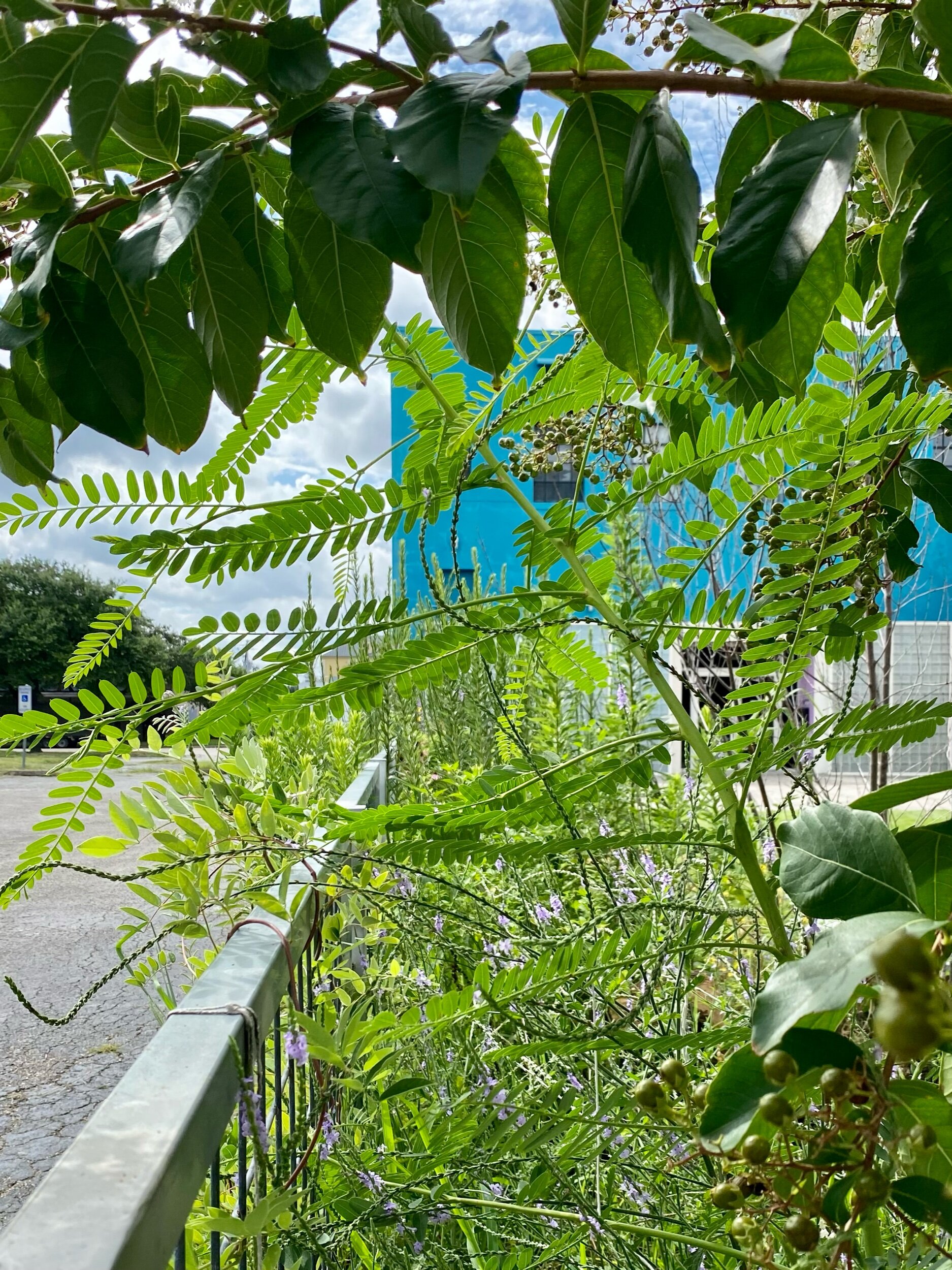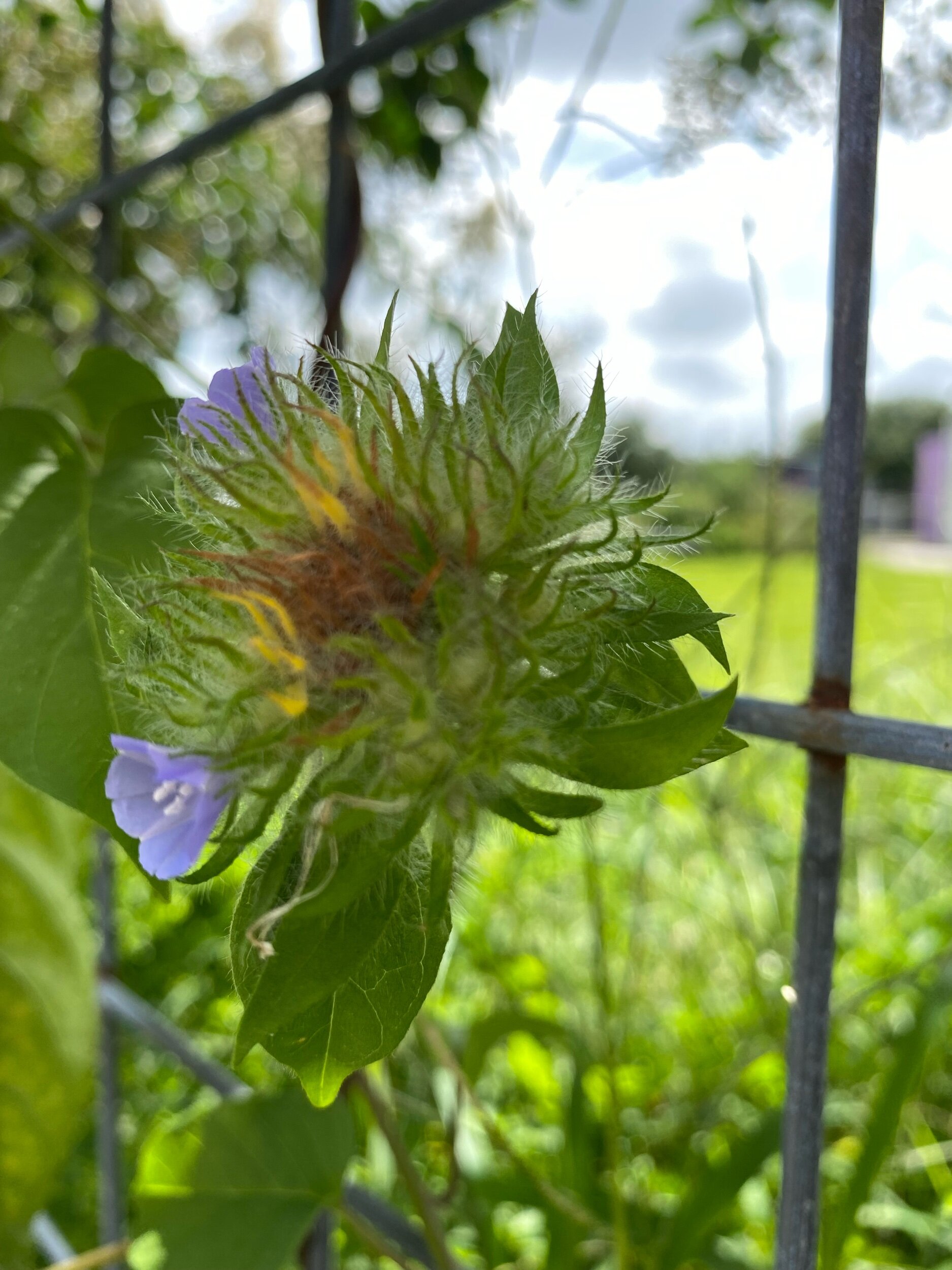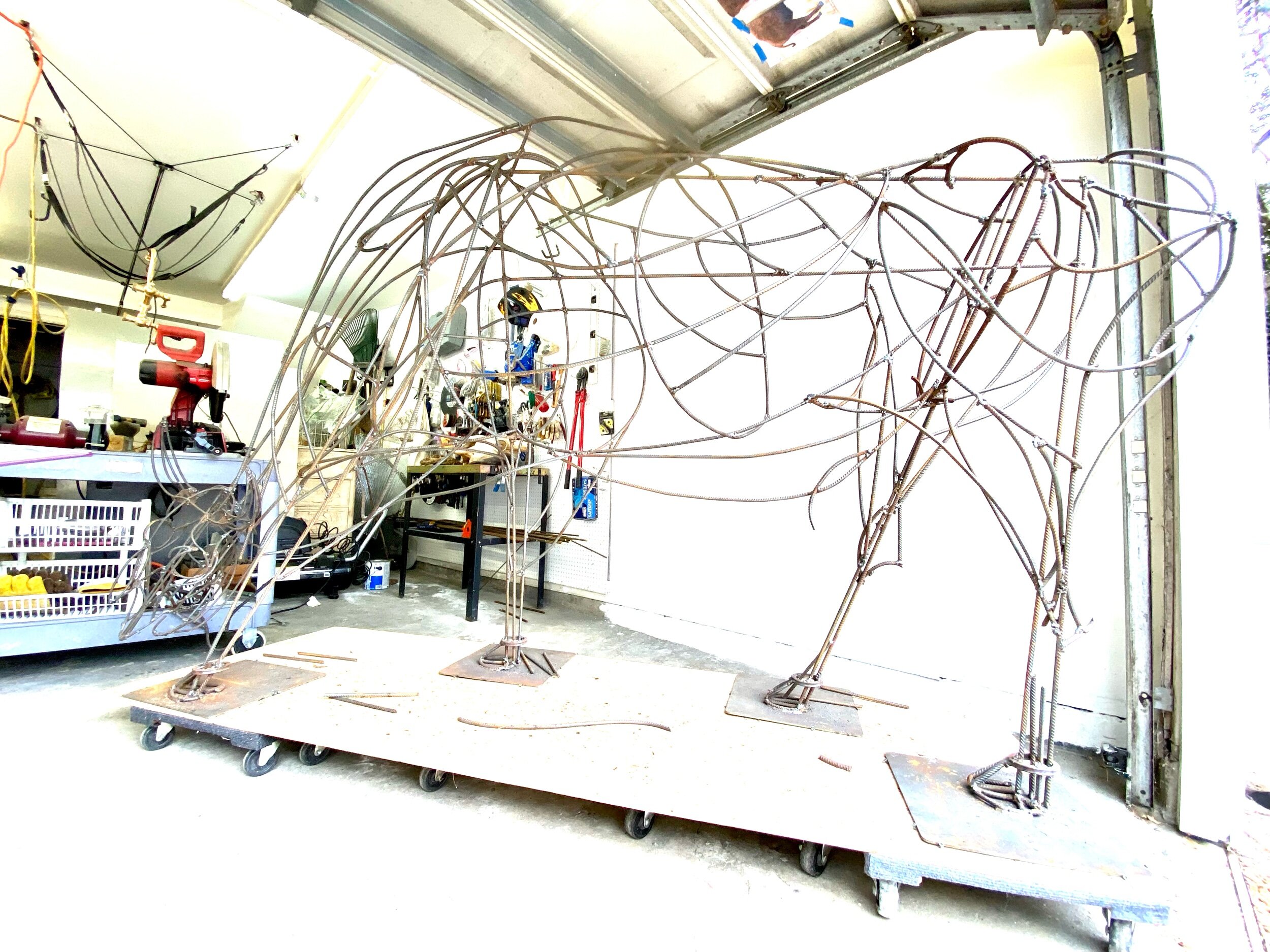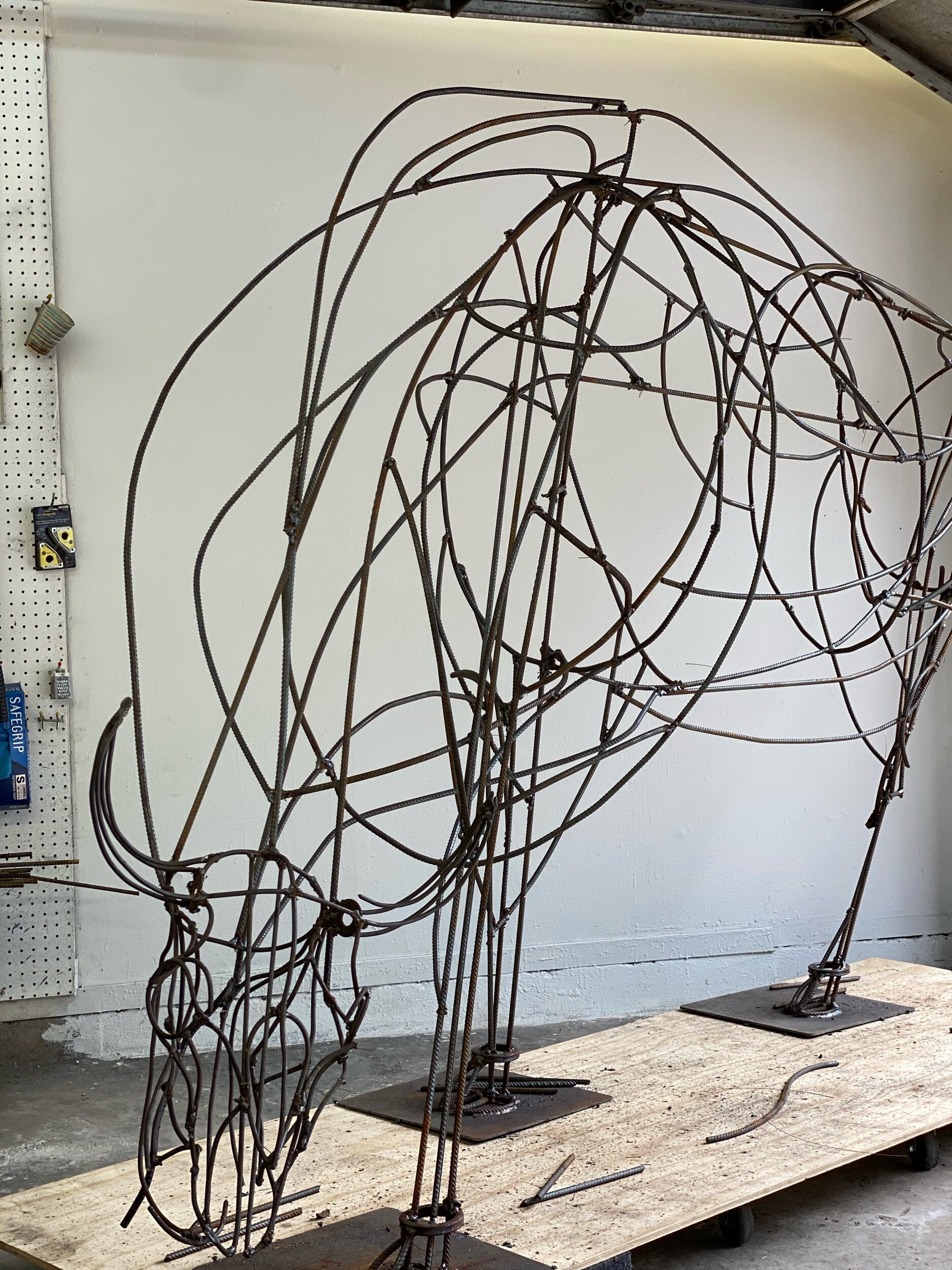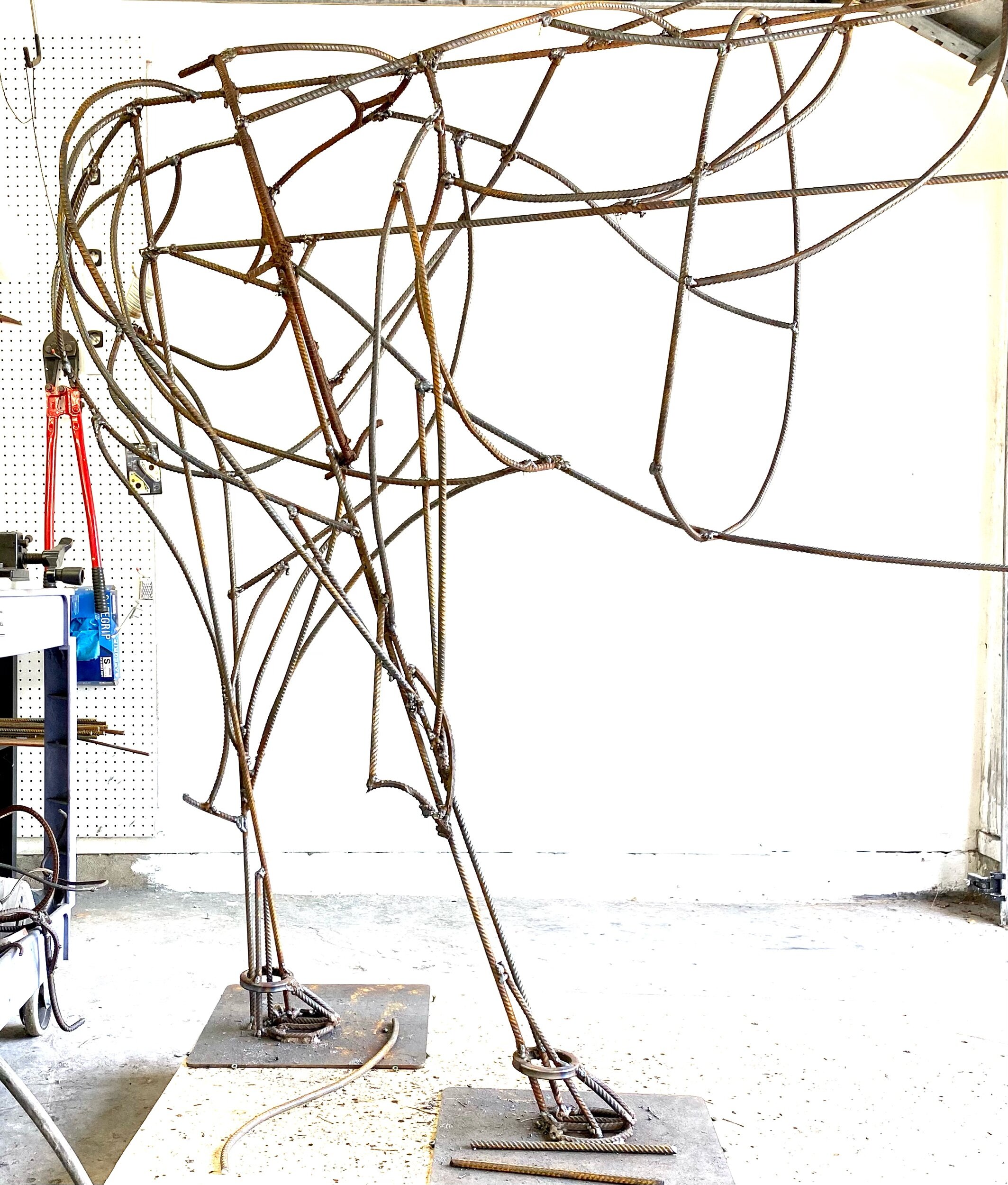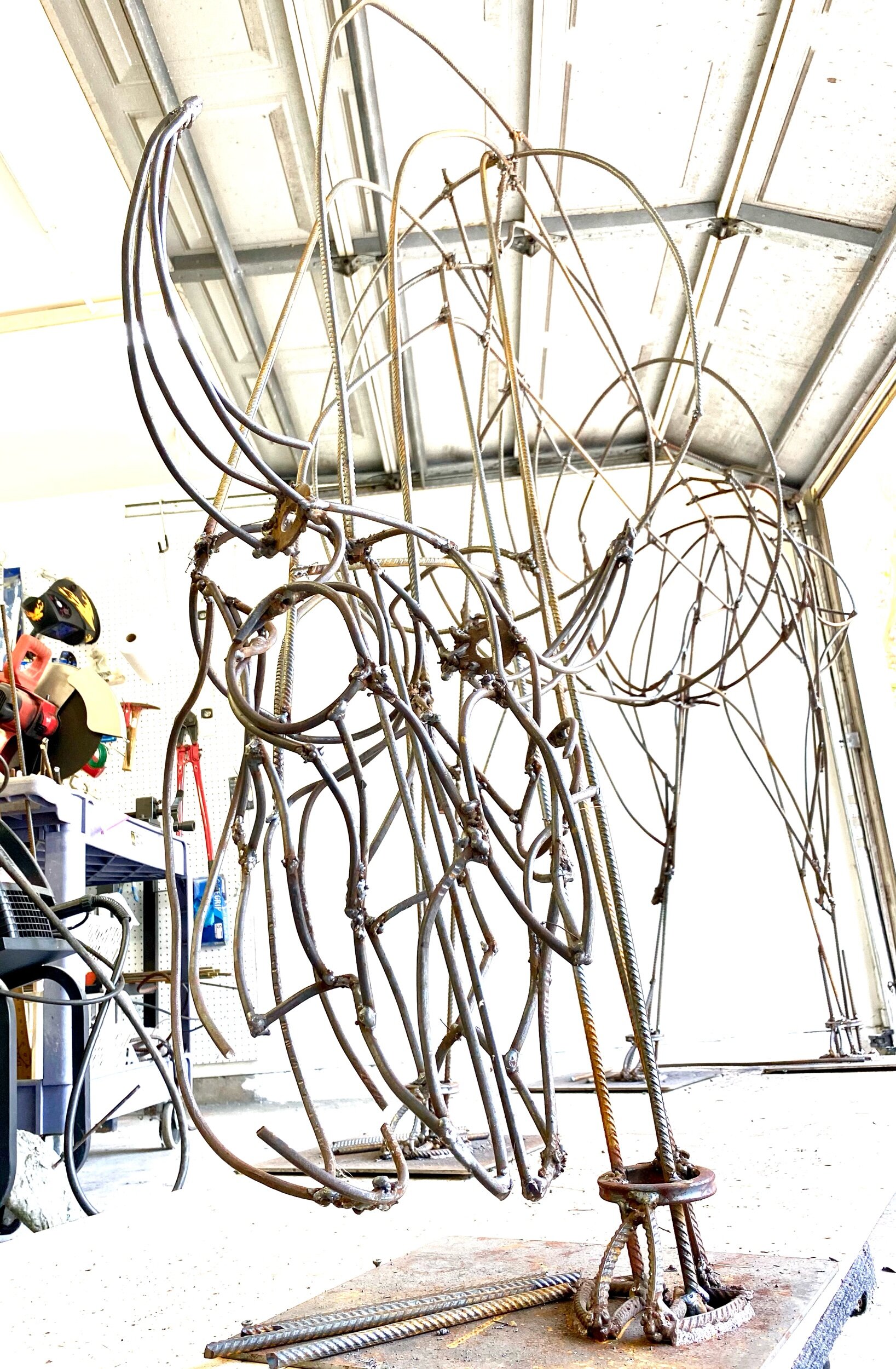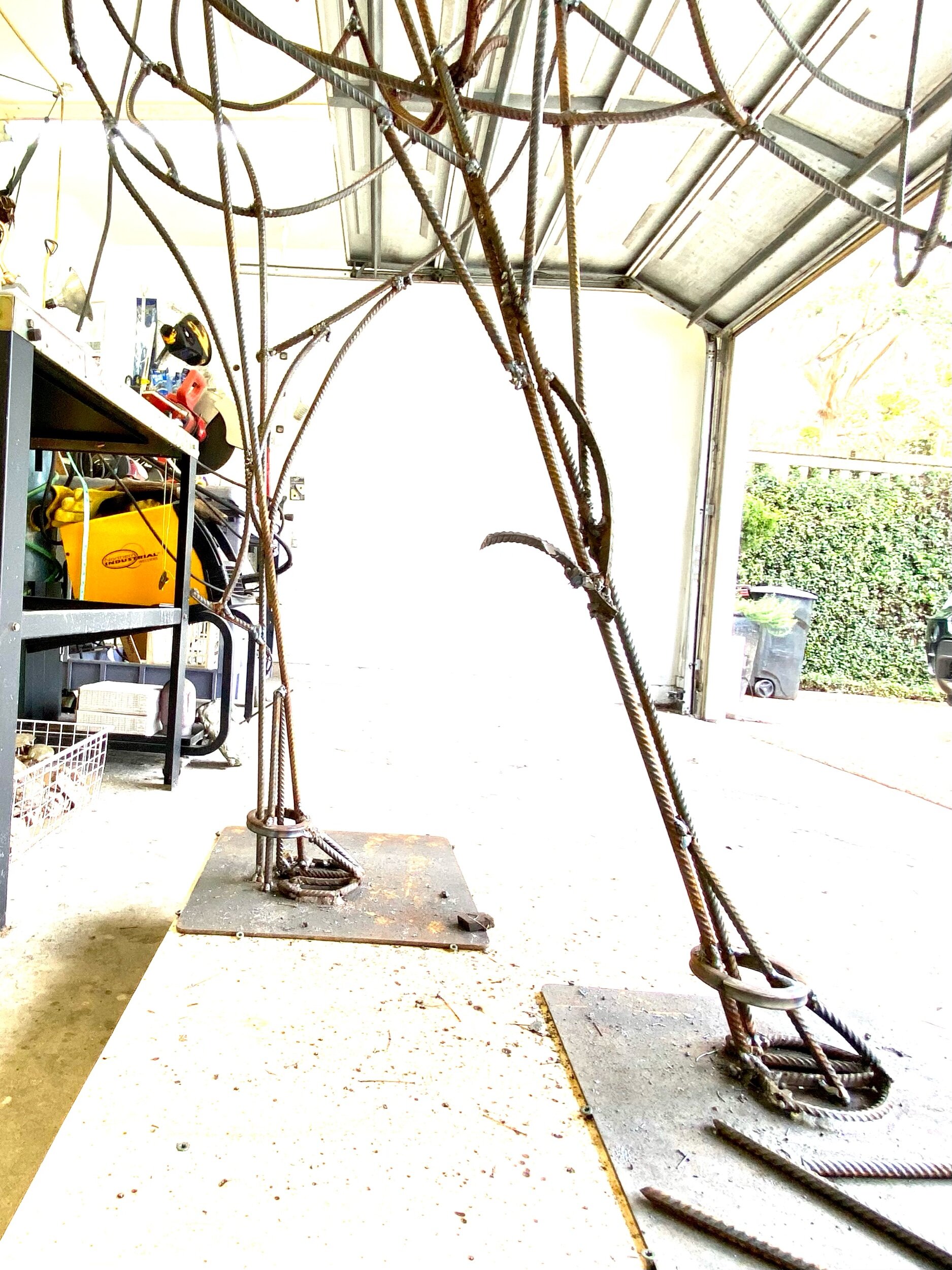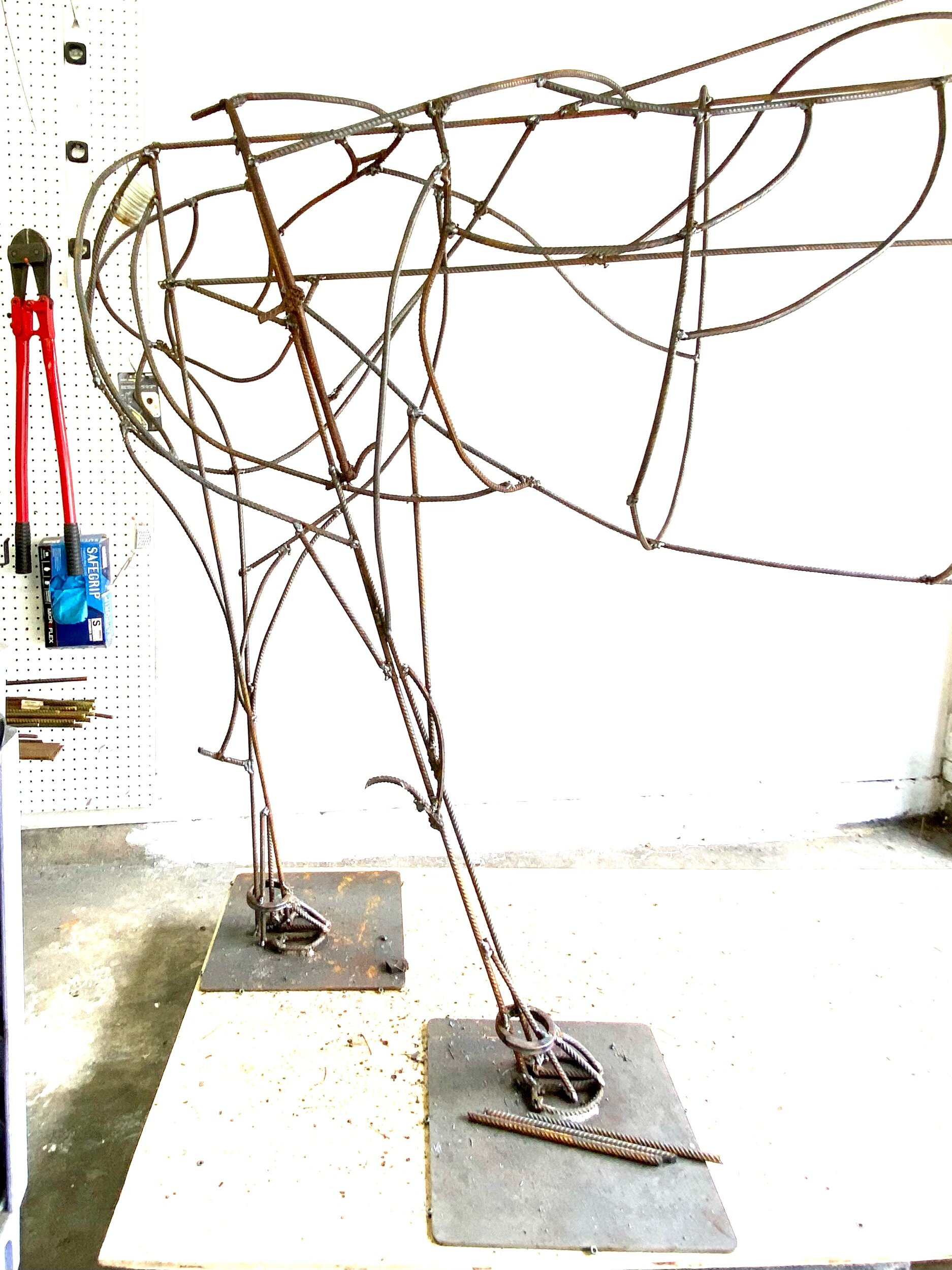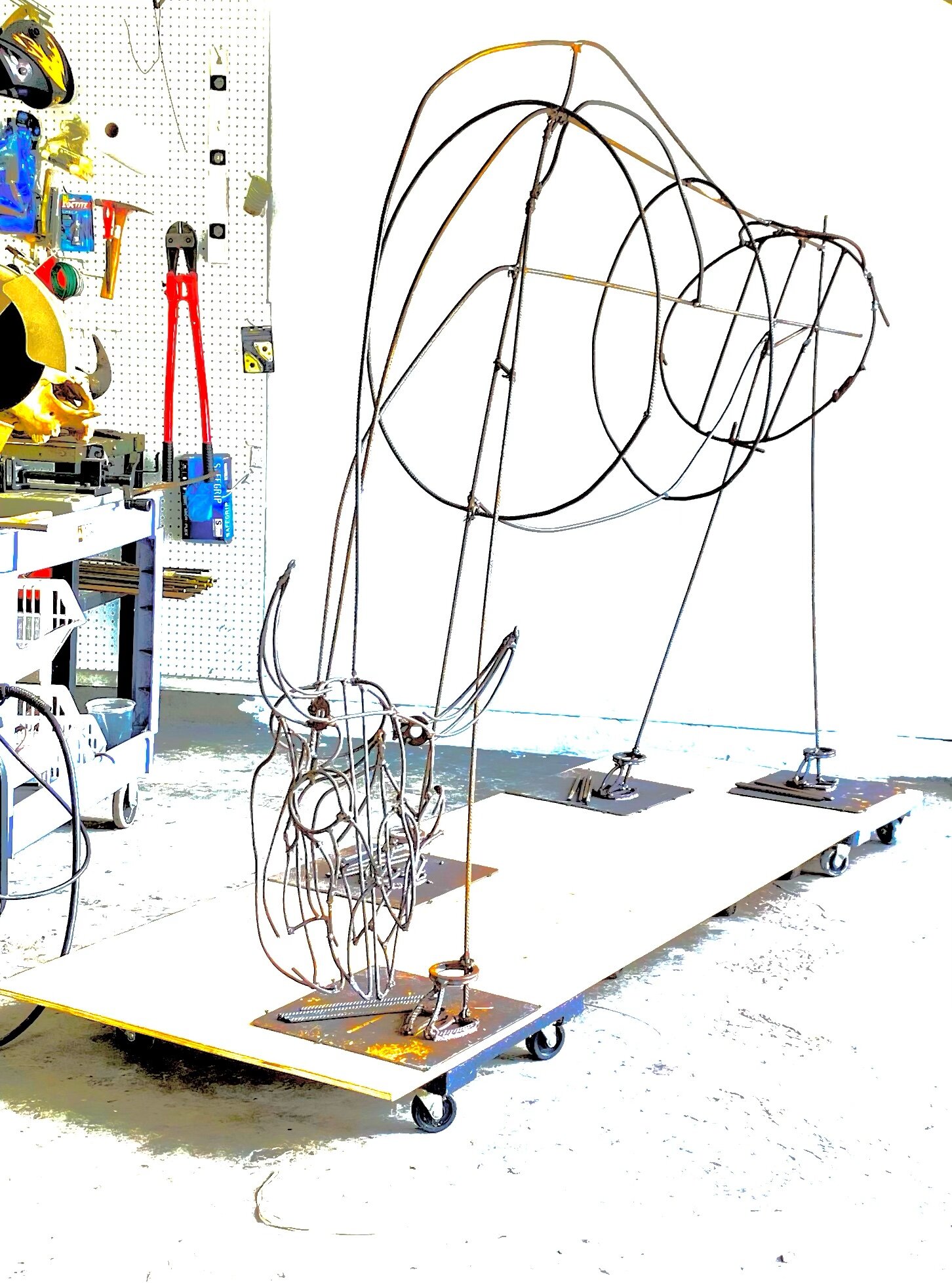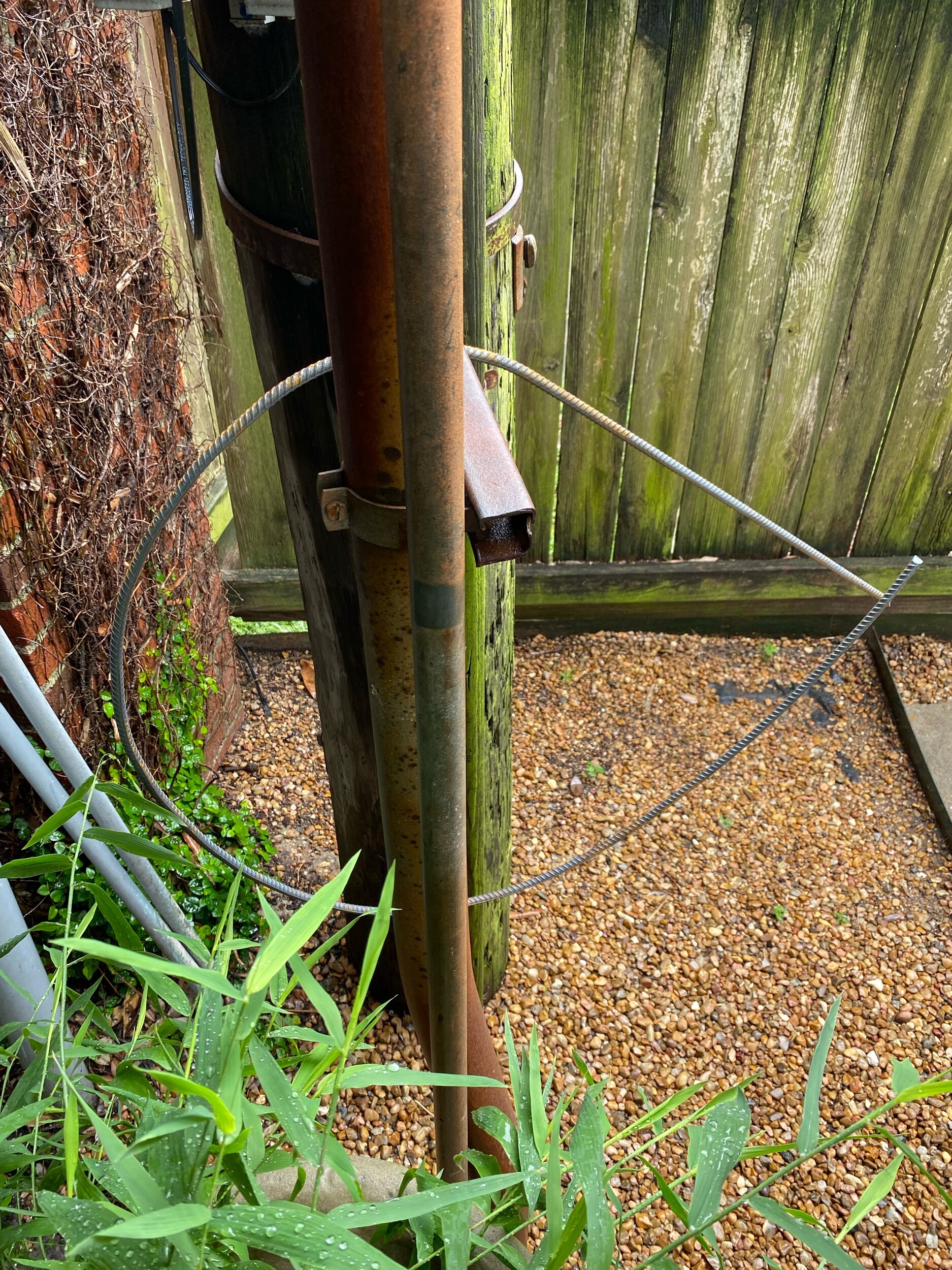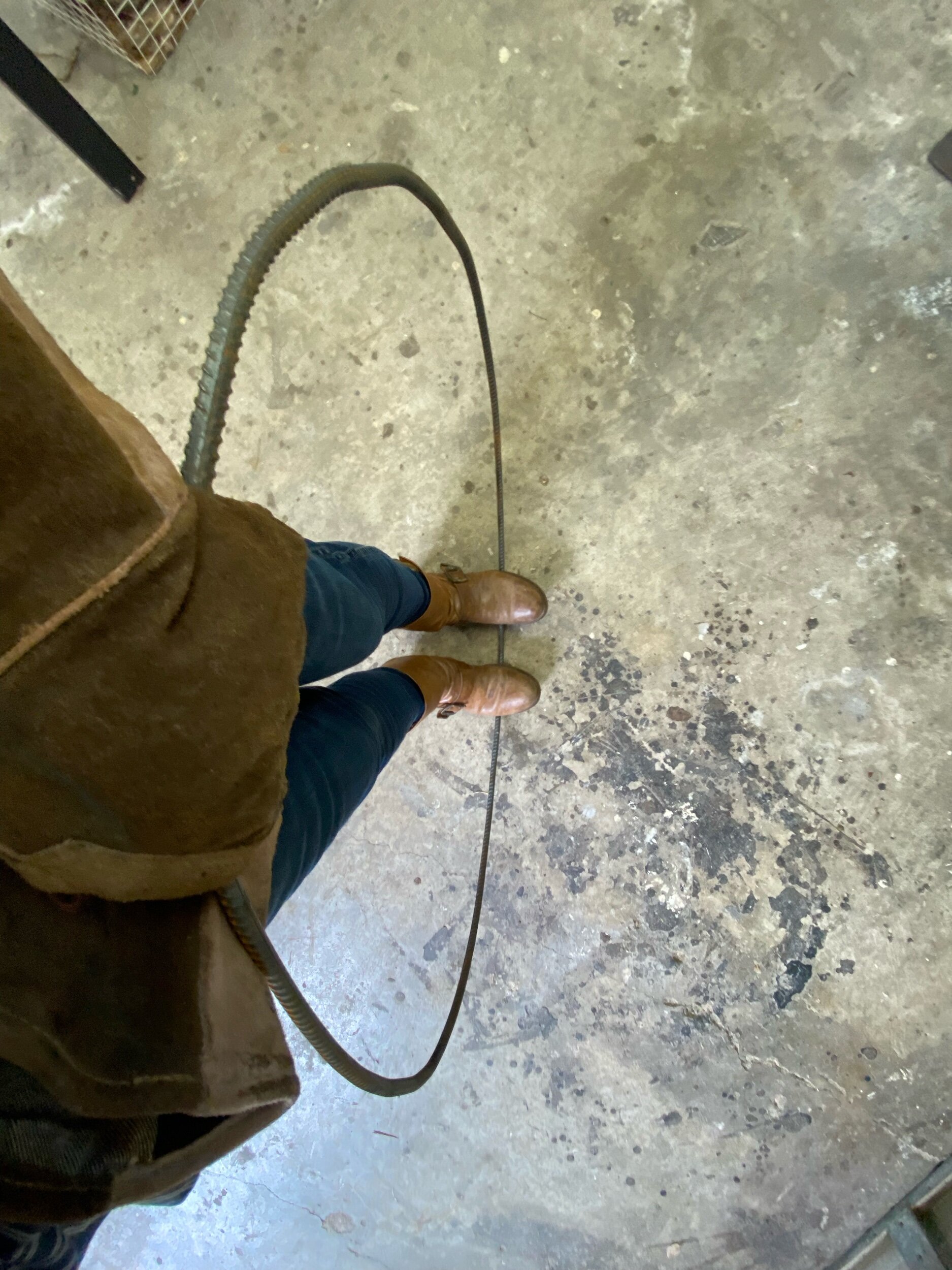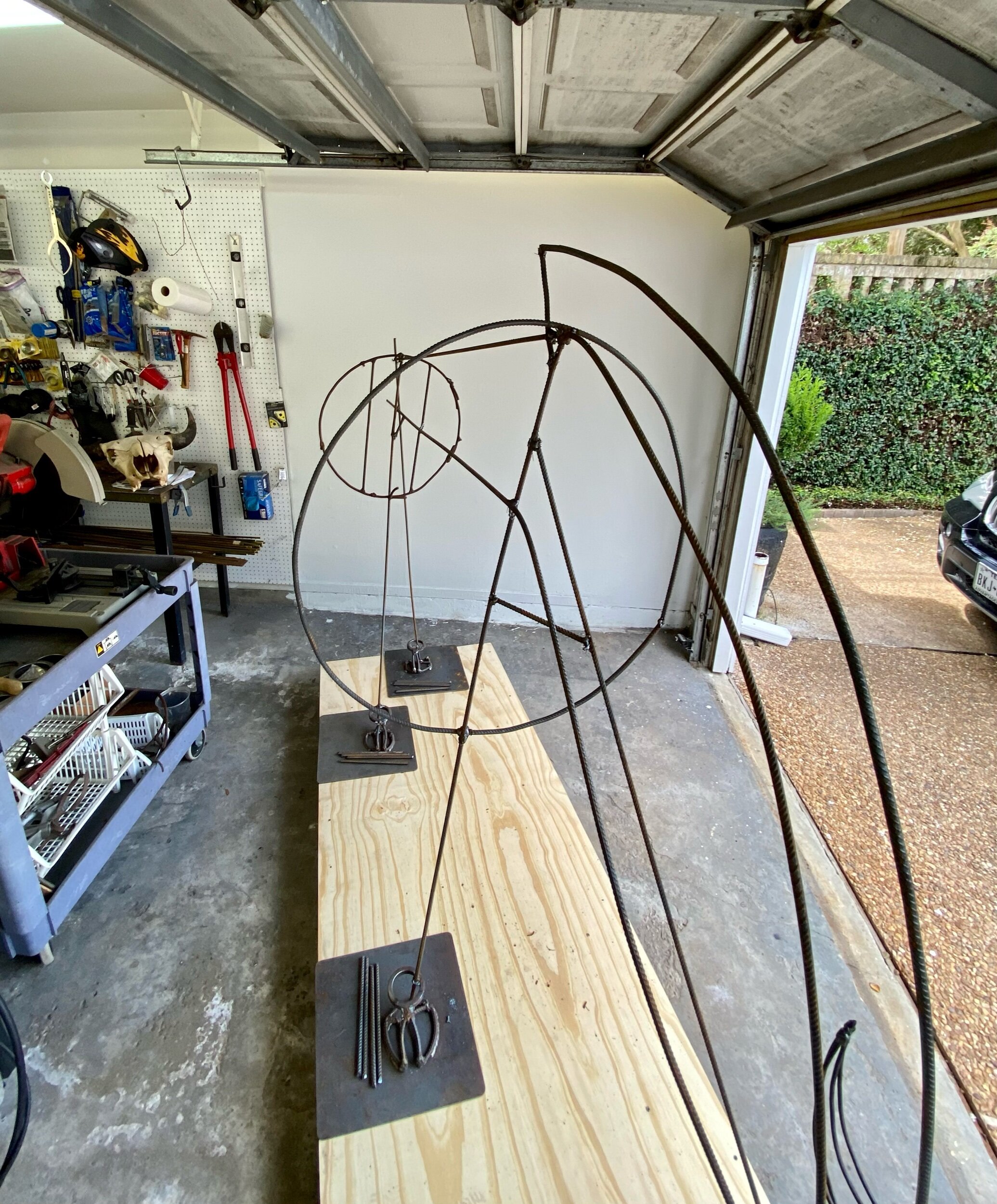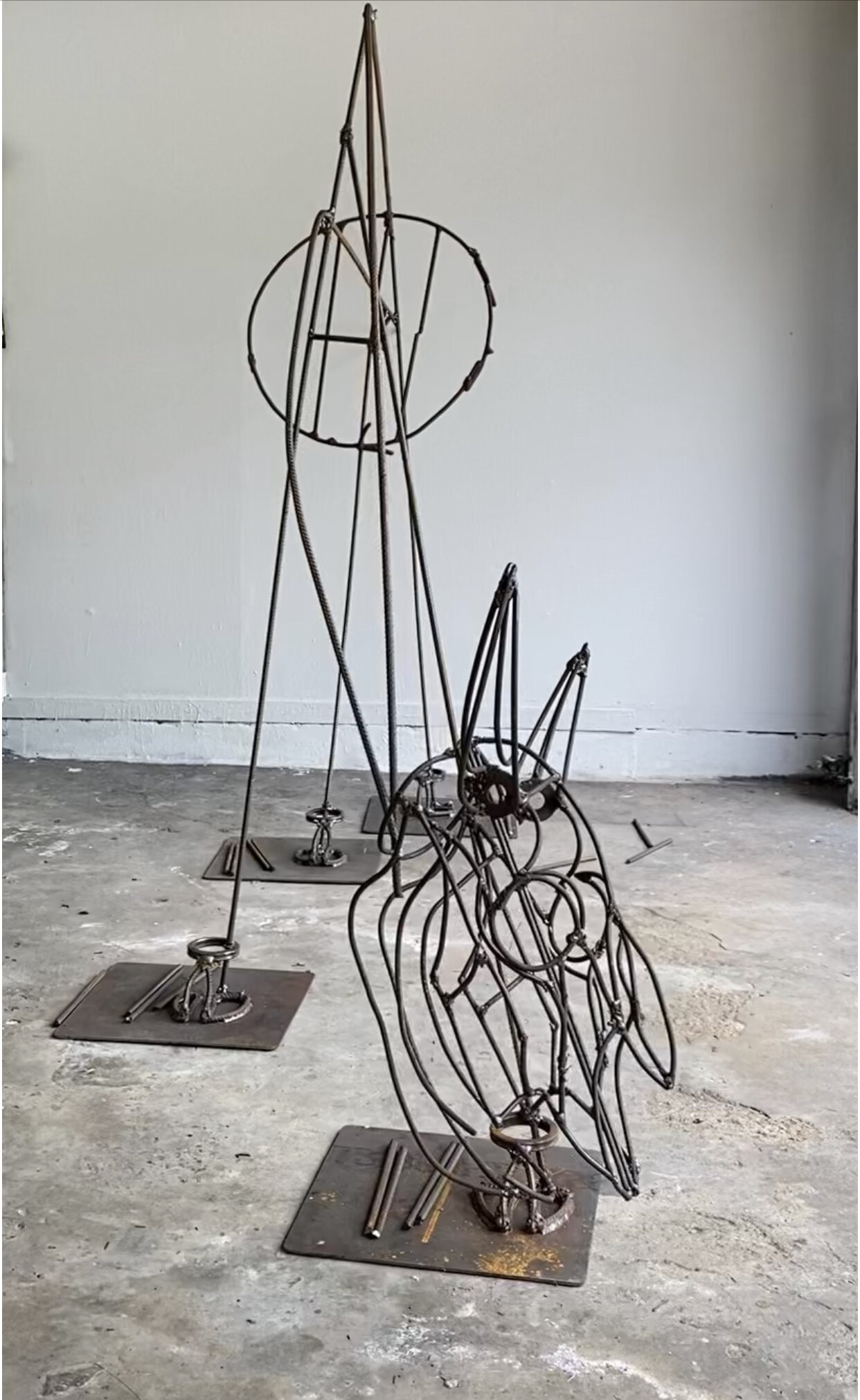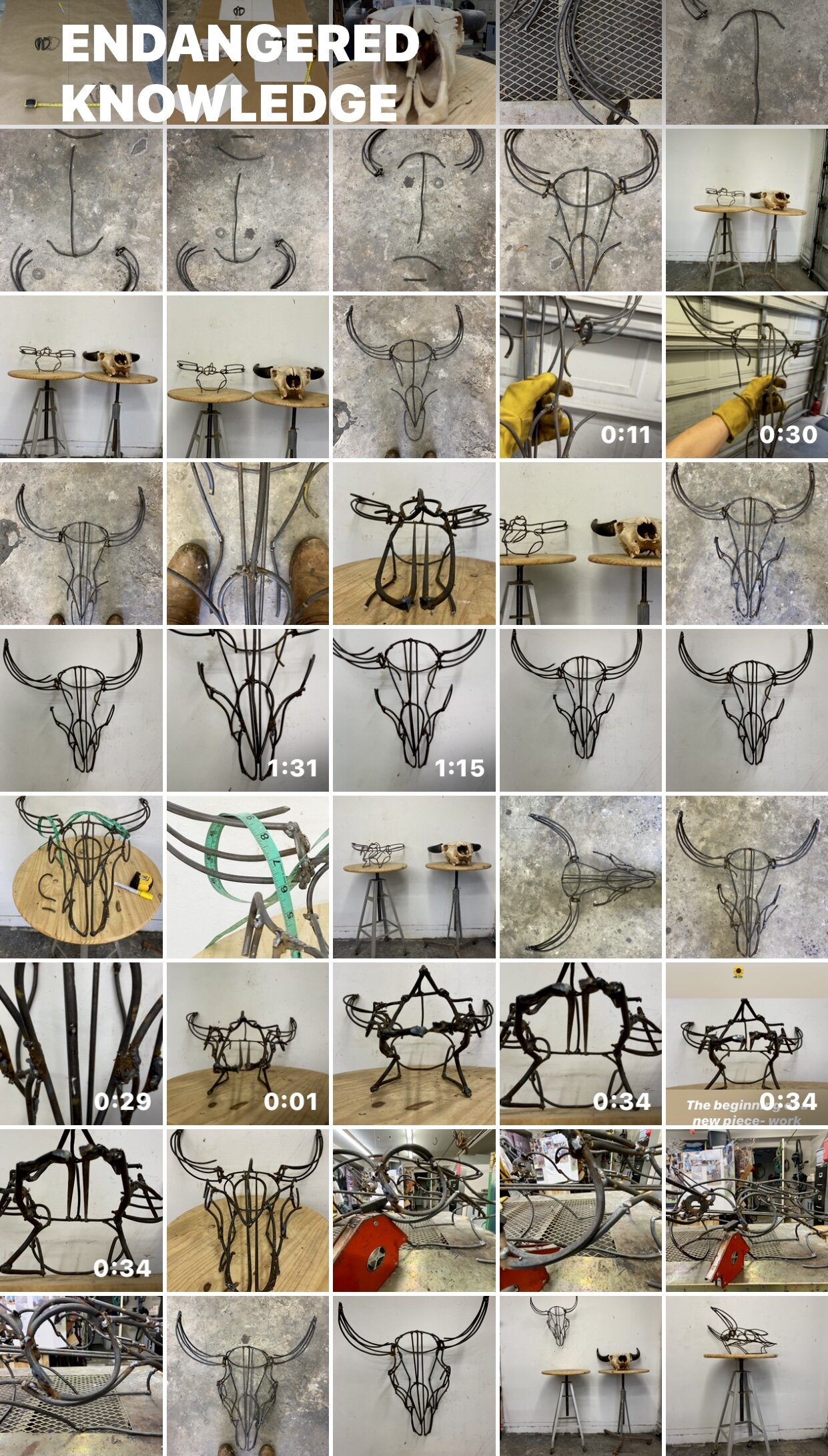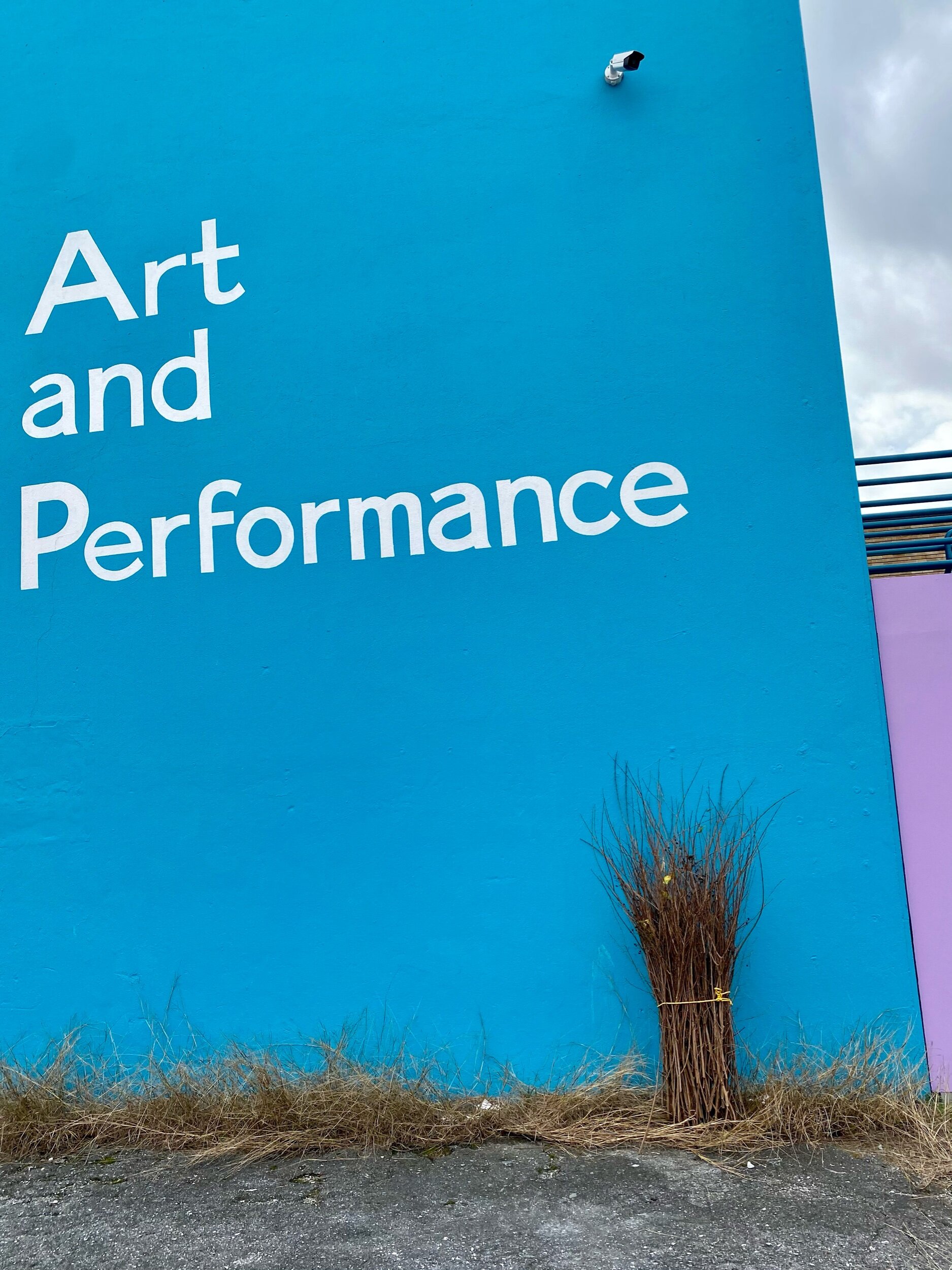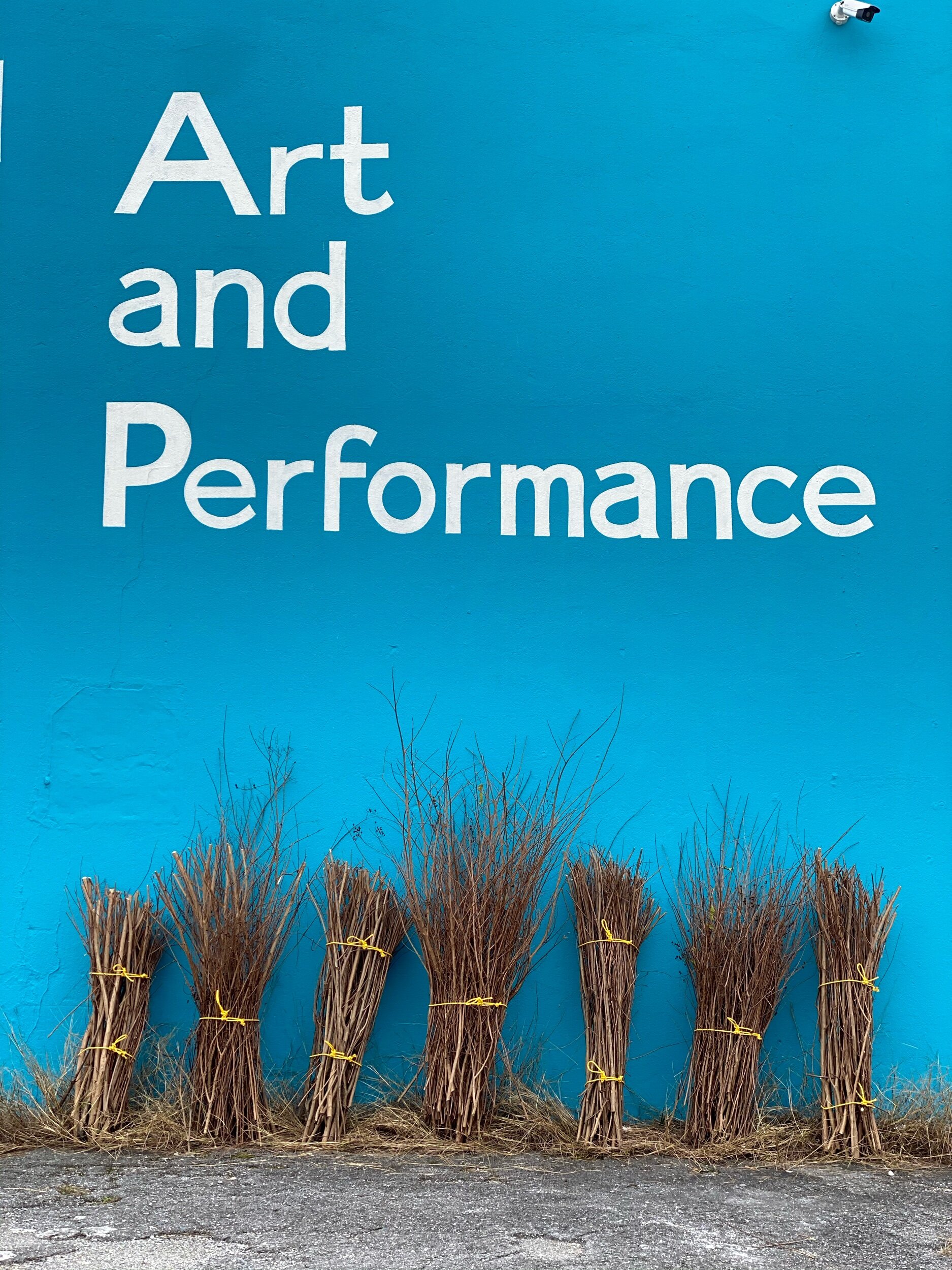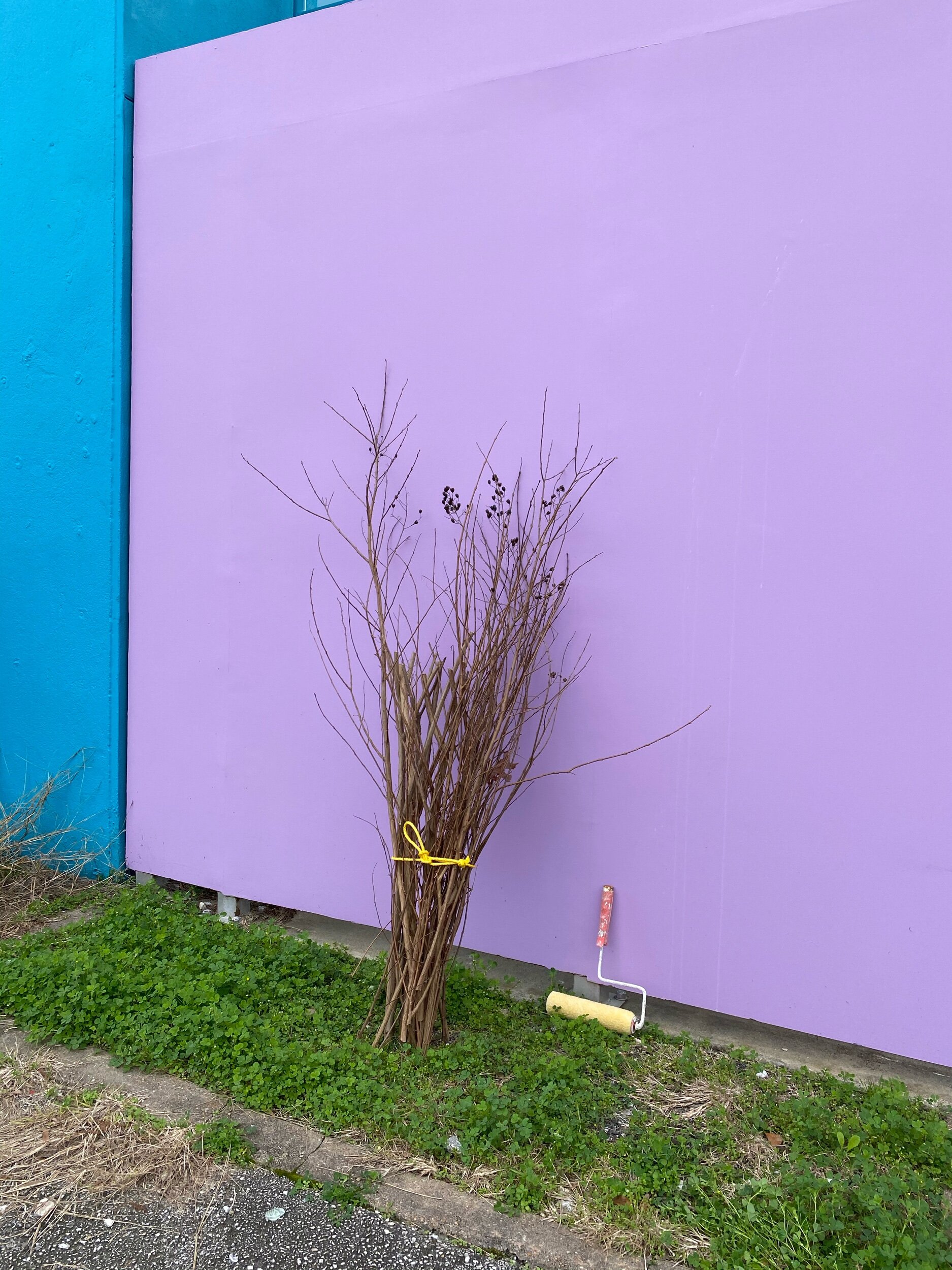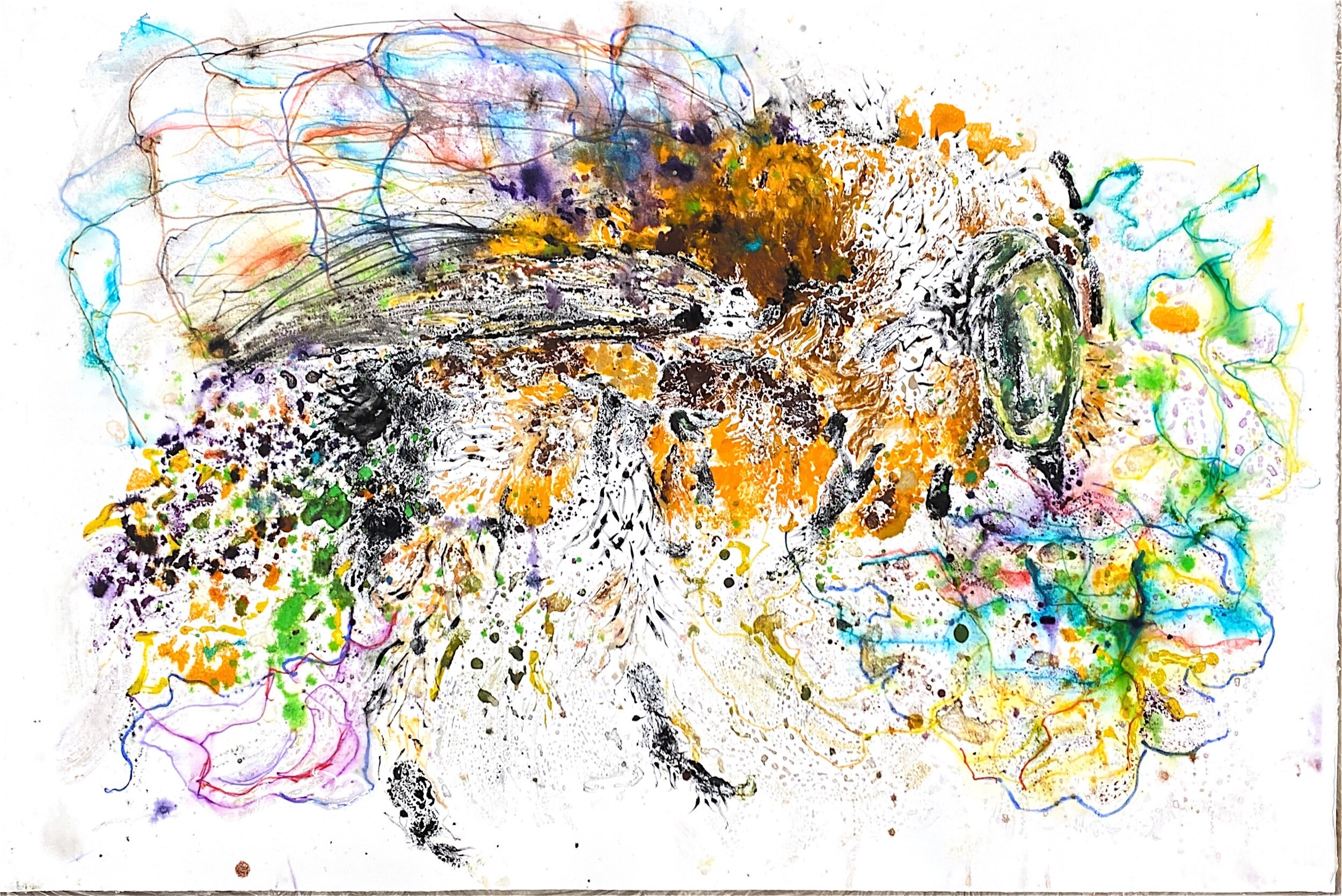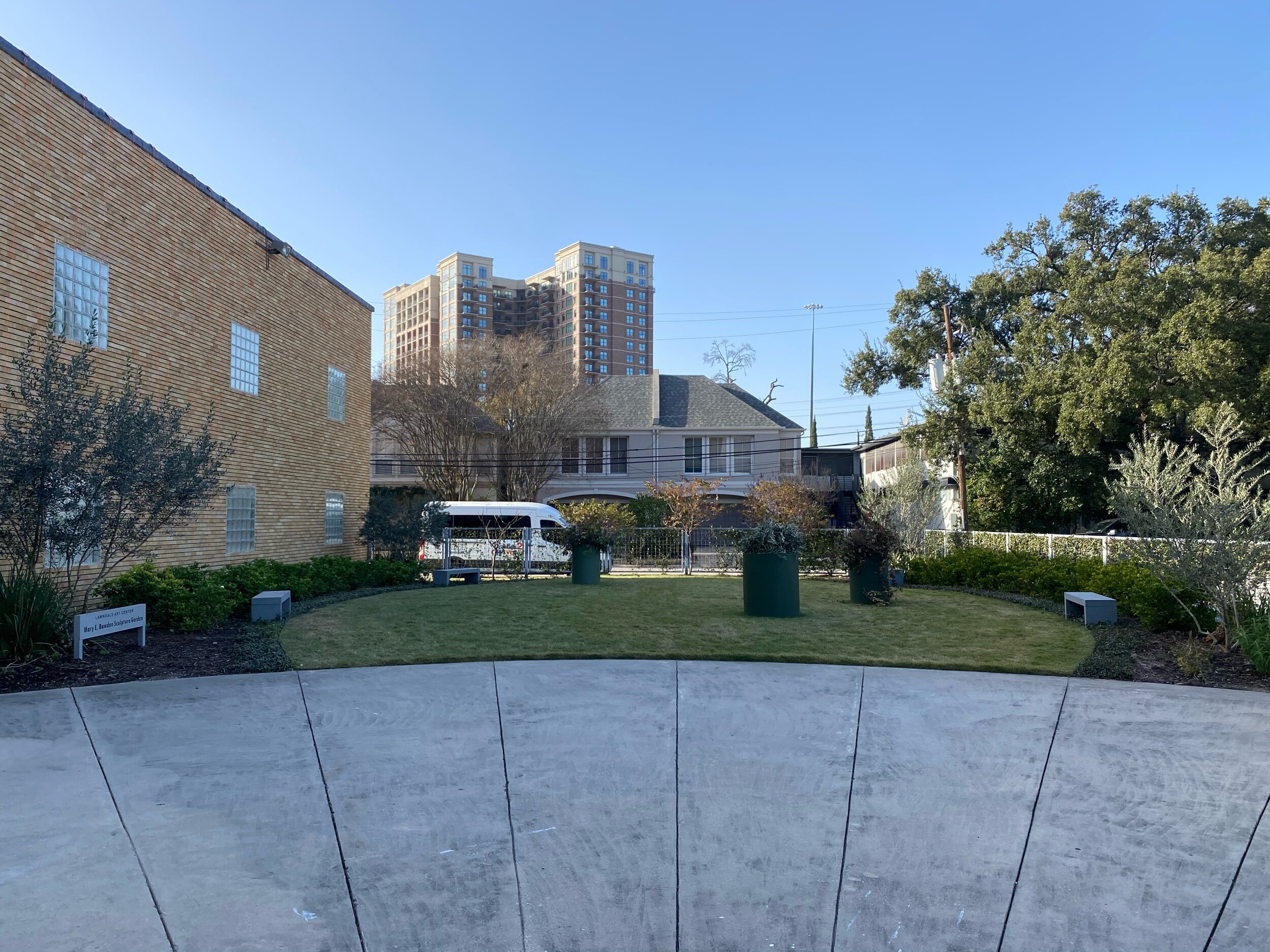Today‘s progress may not look like much, however I worked 7 hours. I was focused on filling the tiny spaces in the groin, inside its flanks and rear end. And I was careful not to catch my skin on the sharp edges of the late. It is razor-sharp and requires careful deliberate moves.
Endangered Knowledge: The Soul of Humus
Today's work
Yes, I use a sewing tape measure
I worked on his middle
Endangered Knowledge: The Soul of Humus
A few weeks ago Nash Baker took some in progress shots of my SMH piece. Then I had two weeks of off and on heat exhaustion. It is a rough summer to have an outdoor living sculpture and a piece that requires welding in a space that does not gave AC. I have finally replenished the minerals in my body and I am back to work on my bison. The temperatures are going to be extremely high this week to work outside. :(
Working on Endangered Knowledge: The Soul of Humus in my garage welding studio
Photo by Nash Baker
Symbiosis — The Symmetry of Weeds, Ecosystem Services and Art Activism
In June the Lawndale Art Center opened the Big Show. I was very fortunate that nature was cooperating and Symbiosis was vibrant with both plants, pollinators and insects. The skies were full of dragonflies of every color, there was not a mosquito in sight. The bee balm was a bee crowd-pleaser and the passionflower was crawling in caterpillars. It felt good.
For approximately two weeks after Houston received large amounts of rainfall. Rain or shine I still went every day to observe the landscape, look for signs of new urban wildlife and learn from the work. I saw that a living sculpture is a moving target. During this time period, plenty of volunteer plants appeared, covering the spots of bare earth as nature knows is best. I diligently photographed the volunteer plants and researched them through my National Geographic citizen naturalist iNaturalist app. If they supported wildlife and they were in a location that they were not distracting I left them. If they were visually obtrusive or blocking another plant's growth or light. I pulled them. I winced with each pull, my instinct in regards to healthy soil and natural solutions was to leave them, they are sequestering carbon, any disturbance of soil releases carbon. Weeds have a role in the ecosystem: they establish quickly, protect exposed soil, provide habitat for beneficial organisms. Weeds are a natural response to heal disturbed earth. From an environmental point of view, they are a benefit to the landscape. From an artist's point of view, I love the weeds. They add a variety of line, an unexpected pop of color, movement, rhythm and a variety of patterns. As a sculptor interested in ways I can incorporate time snd movement in my work, I am a fan of weeds they are a design tool.
That said as an earth conservation art activist the purpose of the work is to inspire others to use native plants in urban landscapes. If the weeds turn people off before they learn about the work, the piece as art activism is a failure. Finding the balance, the symmetry with weeds continues to weigh heavily on my mind. I remind myself of the bigger picture—activate change, create a micro-ecosystem that others will be inspired to imitate. I know change can happen at lightning speed when innovation is coupled with imitation.
Phytolacca americana, also known as American pokeweed,
Detail of Phytolacca americana, American pokeweed,
Sesbania is a genus of flowering plants in the pea family, Fabaceae, and the only genus found in the tribe Sesbanieae. Riverhemp
a nitrogen fixer
“Nitrogen is the element responsible for lush green plant growth, but plants aren't actually able to use the nitrogen gas in Earth's atmosphere. Certain plant species, though, harbor bacteria in their roots that convert nitrogen from the atmosphere into a form that plants can absorb.“ learn more here.
Aesthetically as an artist this quiet corner of graceful movement is inspiring. The repeated surfboard shaped leaves delicately attached to the slender stem create a stunning rhythm and repeated pattern.
Jacquemontia tamnifolia Hairy cluster vine - insanely cool bloom, complex in its texture, shape, and color palett.
As stunning as this complicated vine’s bloom is I could not find anything about it it online, except it is capable of surviving fires. It does have the physical characteristics that attract bees, blue petals, and exposed stamen. I will take the risk and keep it. With any luck it will support at least one of pollinator species that we do not yet know we have lost. To return what we do not know we have lost is what inspires me to do this work.
I came across an invasive species, Fatoua villosa Hairy Crabweed. see future Symbiosis post
Endangered Knowledge: The Soul of Humus
Progress from the last two days of work.
Sagged bellie and manhood
Endangered Knowledge: The Soul of Humus
Ferlocks, hocks and nape
Right front leg chap and starting to build the neck muscles. The neck muscles are massive.
I build the legs on separate days. Left keg the hock curves up and right keg the Hock curves down. I still need fetlocks. I think bison have two per foot. More research
Endangered Knowledge: The Soul of Humus
Todays work- His right back haunch and leg.
Symbiosis- the tools of my collaborators
In creating a living sculpture, I have to accept change. I can not control the piece nor do I want to. From soil microbes to leaves, petals and butterflies, bees, skippers and caterpillars, I am always looking to the natural processes. I look to see what does the material want to make, what does it need to be. Competition, succession, disturbance, consumption are the sculpting tools of my collaborator, characteristics of the work. I have to let them follow their path to self-design their regenerating community. I bend my creative processes to the design principles developed through the ages on this planet for this place and time. The time is right to change how we landscape. I believe Houston is the right place and Houstonians the right people to plant the seeds.
Competition
Succession
Disturbance
Consumption
Endangered Knowledge: The Soul of Humus
20’ more of rebar.
I used 20’ more of rebar today to build the hip bones up on both sides and his right side in the stomach area of his side. I worked from the hip to his shoulder.
My work space is not large enough to get a good side photo.
Endangered Knowledge: The Soul of Humus
Stomach, upper hip bones, and more hump.
He still looks like a hybrid giraffe bison, that is only because his muscles and fur come later.
Endangered Knowledge: The Soul of Humus
Another big day of welding..I added a big 96” circumference chest. Put the entire piece on four dollies and started his hump. Below are a few pics from todays work.
Behind my garage is a telephone pole. I use it to bend my rebar. This is a side view where I am going to bend the piece for the chest.
Halfway to becoming a bison chest.
Then I use my weight to even out the shape.
I hang the chest over the back and decide if it is big enough.
Next I weld the ends together .
Recycling some old dollies from past work and deciding on the best plan. Balance and portability is the goal. The brown paper is the footprint of my bisons. Each leg is supported by a dollie.
Thanks to Curtis for getting me the plywood and helping me mount the beast. This is just for while I work on the sculpture and for transportation. It is not part of the work.
Just goofing around
My garage studio assistant is taking a sun break.
Starting to assemble the hump.
And that's a wrap.
Endangered Knowledge: The Soul of Humus
July 5th.
Attaching the head—
I welded just one connection from the neck to the head. As I assemble other parts of his body I will continue to evaluate the position of the head. I want him to be his reaching to the side searching for the next blades of grass within the reach of his massive head and tongue. With only one weld I can easily cut it off if I decide it is not in the right place or at the right angle. I do enjoy having a bobblehead bison in my garage for a while.
Building the girt—
I happened to have a circular scrap piece of rebar almost the right size. I created it years ago to be a round seat for a faux bois chair that was started and not finished. I turned it into the basis for the bison’s rear hip girth/stomach.
It is a little small, the small size gives me the flexibility to add to it exactly where I want it to protrude. As I get more elements worked out I will make it larger by adding the back hip bones that protrude. t is a lot easier to add pieces as I build him than to cut out pieces.
1 small tack world neck to head. Just to see where I want it.
Endangered knowledge: the Soul of Humus.
SMH fall of 2020 was canceled due to Covid 19 last July of 2020. I put a halt on welding my piece and focused on planning “Symbiosis.” “Symbiosis” is installed the Big Show is opened which provided a tremendous amount of traffic. I will still check on it every day, but I will spend most of my day building my piece for SMH 2021. Today I started where I left off. Below are images from last year's work and blog posts.
When I stopped in 2020 I had the hooves on steel plate bases and new where I wanted them to bare the weight.
Today I cut the rebar to form the lover part of the legs and grinded the tips. Tomorrow I weld.
Some of my notes from measuring Epics Bob the bison January of 2020.
My bison will be in motion not standing still.
The skull and upper jaw.
And lower jaw
4 pieces of rebar cut for each leg will provide the structure of the lower legs.
Spontaneity and art - a good thing, we will see
I started my day at 6:30 am, pasting images of work into a word document for a curator/art consultant. A necessary task that I was thrilled to do- however, mind-numbing, to say the least. By 12:30 crossed eyed I took the dogs on a walk. When I came across this. My mind numbing was instantly healed with inspirational thoughts.
Seven immaculately bundled trimmings from a neighbors Crape, Myrtle. Crape murdered or not I- the trees were in the backyard, could not see them.
My trimmings from a site-specific installation @Lawndale Center for the Arts. Symbiosis
The image above is from last week at Lawndale (a post in am tardy with) My trimmings are wild and unruly. I am using them on social media to make a point - to change how we landscape- to landscape with habitat for wildlife in mind.
My neighbor's bundles of limbs are in sharp contrast to mine. They are an example of how controlling urban green spaces have become, the tidiness that is expected In our yards.
I am so tempted——— Such a great opportunity to turn these found object organic materials, perfectly assembled tied up with yellow cords into gorilla art. The colors will look amazing at Lawndale. It is not part of my work on Symbiosis to install anything I want. 🤔 The entire dog walk I was haunted by the bundles and their yellow cords. I am not comfortable installing gorilla art but I am excited with the idea and I know Lawndale won’t have me arrested like other institutions might if I randomly installed objects in their sculpture garden, right?
I have always challenged myself to take on the art that scares me the most- to embrace the butterflies as my son tells me. You don’t know until you try. - jump
I went to the door, I was hoping no one was home, Abby was a new neighbor and I introduced myself. - she moved in during Covid. We had a nice chat and she welcomed me to take her piles.
It took two trips
😁 when I bring new materials to Lawndale, I like to photograph them on this turquoise wall- documenting my materials. And I have to say! I love the colors - the Textures.
I declare this installation number 1. Untitled.
This technically is not Lawndale property, the wall is theirs, but the lot is unfortunately not owned by the institution. The lot is vacant. I get all the bundles out so I can pick up load number 2.
Installation number 2
Installation number 3
The yellow ties make my heart sing, that rich brown against the turquoise, and the golden grass softening the base, I am in heaven. I see ballerinas chins up, lined up to take their bows center stage. I had one left.
A painter from last week left their yellow roller- waste not want not. The clippings Are rich on the violet too.
Sometimes I feel guilty that I love my work so much.
There are bees that have not been seen since the 60’s that are not listed as endangered.
After reading the document that listed Bombus Affinis as an endangered species I formed my own opinion by and it does not reflect well on the chemical industry.
Bombus Affinis - the rusty patch bumble bee
The bee that pollinates tomatoes is not the honeybee.
Summary from sciencedaily.com
The yield and quality of many crops benefit from pollination, but it isn't just honey bees that do this work: bumble bees also have a role. A team has used innovative molecular biological methods and traditional microscopy to investigate the pollen collecting behavior of honey bees and bumble bees in agricultural landscapes. It turns out bumble bees take much more pollen from different plant species than honey bees to satisfy their need for protein.
bumble bees are superior pollinators of tomatoes than the honey bee. The southern carpenter bee also pollinate tomatoes.
Turning back the evolutionary clock evolution in urban neighborhoods
4" X 13" X 8"
bronze
photo by Nash Baker
The sidewalks in my neighborhood are my nature trail. I walk with my eyes on the prowl for intriguing insects, exoskeletons, insect wings, feathers, dried flowers, twigs, leaves, seeds, and pods — things my children’s eyes taught me to find during our walks together over the years. Since 2013, these biological mementos have found their way into my bronze work in the molds of nests. Each piece is a reflection of that year’s ecology and records the time and movement of environmental restoration.
Initially, I was unaware of the landscape around me, but as my art dove deeper into environmental restoration and Hurricane Harvey changed our city, I realized that my days are, in fact, full of sterile surfaces. With COVID-19 quarantine, children in my neighborhood started venturing outside and looking for things to capture their curiosity. Delighted with their new interest, I realized that the green spaces and puddles children explore now are no longer filled with a diversity of life; the box turtles, bullfrogs, tadpoles, bumblebees, and assortments of flitting insects have evaporated with the spray of insecticides and herbicides in our neighborhoods. The selection is reduced to cicadas, the common beetle, honeybees, a rare native bee, and an abundance of Cuban lizards that dwell in turf grasses, boxwoods, crepe myrtles and oaks. I have awakened to cultural landscape uniformity. COVID has changed how I see the need for perfect lawns; the dirty truth is mosquito home-misting machines, obsessive weed control, artificial turf and a lack of plant diversity have turned urban neighborhoods into manicured monocultures for humans exploring video games. These habitat changes in massive population centers are fast-forwarding evolution: loss of wildlife habitat is one of the biggest threats facing many animal species. This does not have to be—it is a societal choice, the ability to speed up evolution can go both ways. Through my works – Lawndale’s Symbiosis, Endangered Knowledge: The Soul of Humus, Gust, World of Hum, Rumblings and Root to Water—I am committed to creating work that educates and helps communities change how we landscape our cities to include valuing the natural world and turning back evolution.
In Dirt to Soil, Gabe Brown quotes Don Campbell, “If you want to make small changes, change how you do things, if you want to make big changes change how you see.” When I come across intriguing flora or fauna on my urban trail, albeit few and far between, I see them as evidence that can inspire a revolution in the landscape. If they are expired and will not decompose, I collect them. I see these bronze cast nests as urban wildlife fossils—biographies, every year a chapter recording Houston's environmental awakening. As an optimist—environmental—art—activist my work focuses on revealing endangered knowledge to change how we see urban landscapes and activate cooling the planet through our cityscapes. As migratory birds return year after year to build nests and raise their young, I return with optimism in my step. I envision witnessing the return of four hundred plus butterfly species and eight hundred bee species native to Texas. I can see this returned wildlife capturing my future grandkids' imaginations. I will tell them the story of how insects almost disappeared and how every yard is a micro-ecosystem and matters. I imagine their hands building nests with a diversity that I cannot imagine. I hear their voices telling me in one breath about the fuzziest-biggest bee they ever saw, covered in golden dust nesting in a patch of ground beneath the sunflowers not far from the silverleaf nightshade. I see them bringing me a tail-feather from a Red Shoulder Hawk and asking, "what does it hunt" and is it the bird that sounds like the squirrel's screech. After a rain, I see them finding two bullfrogs attached and their tiny ribbons of floating eggs in a pond. I hear them tell me not to touch the caterpillar of the southern flannel moth, and asking me, “how does it sting?”. At the low of evening when dragonflies hover; I will watch as they study the night heron’s quiet solitary stance as it stalks small citizens of the grass, I will smile as they question the raucous warnings of ravens and the scoldings of nut collecting squirrels. I will feel their excitement when neighborhood raccoons appear from storm sewers and scavenge treats from dog bowls and opossums waddle fence lines, searching out grubs and open garage doors. I will follow their eyes when the silent patrol of the lone coyote visits the shadows of our boulevards from their bayou bound dens. I let them sleep outside and hear their heavy eyelids ask, why do the owls ask who? I listen as they wake up to a concert of white-winged doves. I will feel peace when they are wise to nature.
Lawndale Art Center - symbiosis
In a nutshell, this is what I hope to achieve with my site-specific piece, Symbiosis.
I am rethinking the uses of yard clippings.
Lawndale - Symbiosis - extractive
In Symbiosis I am stretching my practice and creating a living piece of site-specific art activism that will reimagine a 53.5’ X 48’ traditional urban landscape/sculpture garden and answer the question: how do we holistically restore an ecological balance in Houston? Symbiosis is a collaboration with Lawndale Art Center’s community, neighbors, urban wildlife, and the coastal prairies carbon cycle.
The west border of the garden has five 1 1/2 year old Crepe Myrtle’s a tree famous for murder. The murder refers to badly pruning the tree- down to the knuckles. I was not having these Crape Myrtle’s murdered. Today I used a extractive method of sculpting and clipped- nipped - and cut the existing branches. I shaped the branches/armature of the two end trees.
A sculpture garden has the four seasons of the year and a sculpture garden has the additional change of exhibitions. The pedestals from the last exhibit were still in the garden. 🤔perfect way to highlight the beauty in the wild- the imperfect- the not immaculate urban landscape.
FYI- crepe Myrtle’s are not native however they are a cherished gift to the Art Center. As an optimistic art activist I look at the project holistically to include the desires of the Art Centers board.
When I work in wire, or steele if I cut too much I can always weld it back it add more wire they are forgiving materials. When I clip a branch it is gone- no second chance. .
#artactivism #cindeeklementart #symbiosis #lawndaleartcenter #nativeplants #coastalprairie #sculpture
Create Myrtle cuttings wildly place on a pedestal.
North West Crepe Myrtle after pruning.
Cuttings from two Crepe Myrtle's and the olive trees from a few weeks ago.
South end Crepe Myrtle












